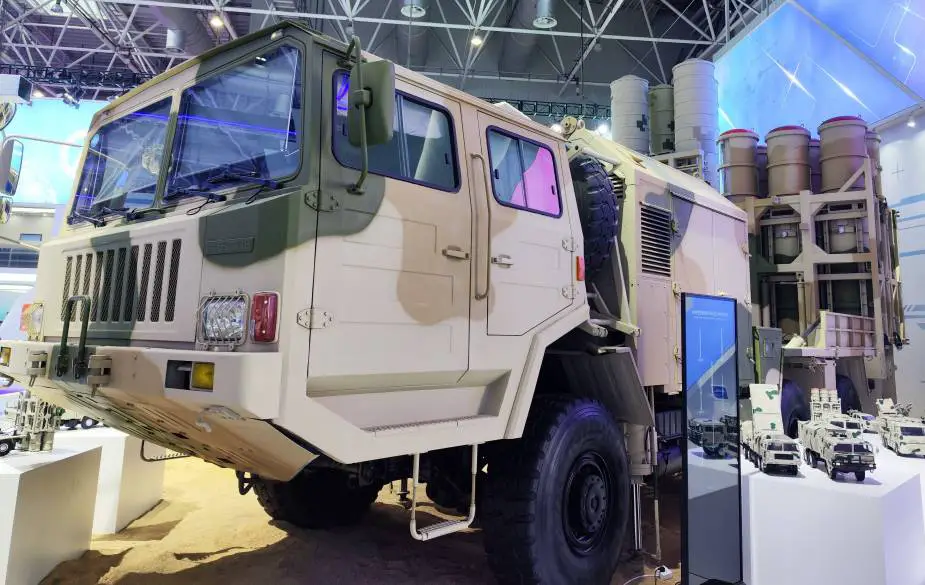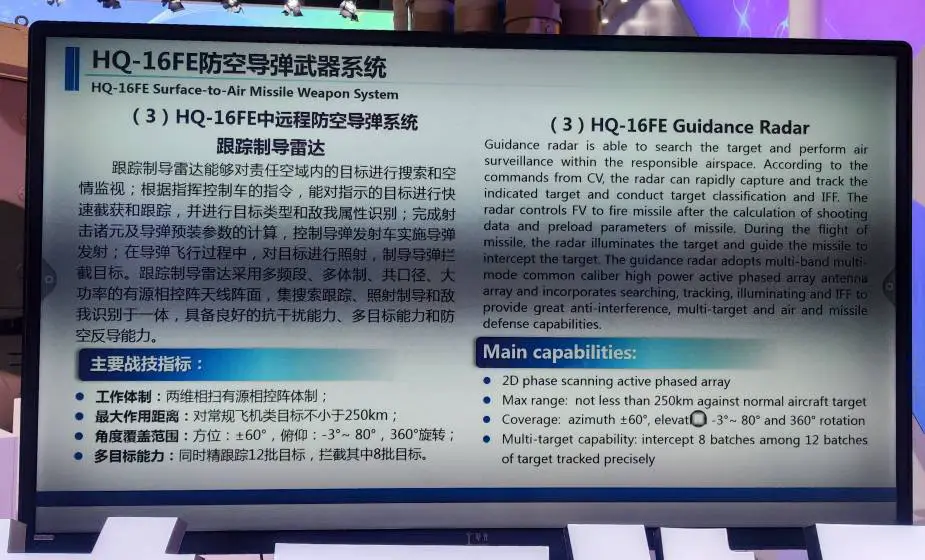At Zhuhai Airshow 2022, the Chinese manufacturer SAST presents a new variant of the HQ-16 air defense system, called HQ-16FE, East Pendulum has tweeted. The flight envelope has been greatly expanded while the size of the container seems to remain unchanged.
Follow Army Recognition on Google News at this link

HQ-16FE air defense system unveiled at Zhuhai Airshow 2022 (Picture source: Twitter account of Eat Pendulum)
The HQ-16 (Red Banner-16) is a medium-range semi-active radar-homing surface-to-air missile. Development of the HQ-16 began in 2005. Some source claims the development was reportedly assisted by Russian company Almaz-Antey, and the system is reportedly based on the combination of Buk-M1 and Buk-M2 surface-to-air missile systems.
Military Watch Magazine believes the system is not a copy of either Buk-M1 or Buk-M2. HQ-16 features a vertical launch system, giving it 360-degree coverage and the capability to fire in a complicated geographical environment, which the Buk system lacks. The missile system is mounted on a Chinese-designed 6x6 high mobility chassis instead of tracked platforms, providing ease of maintenance and better road mobility. In 2011, the development was completed and the HQ-16 was officially inducted into service. In 2016, an upgraded version named HQ-16B was unveiled. Due to an improved rocket motor and revised wings, the range was increased to 70 km. The upgraded version also appeared to have a longer body
A typical formation consists of one command vehicle, one search radar vehicle, 3 radar guidance vehicles and 12 launch vehicles. Each launch vehicle carries up to 6 missiles. According to ArmyRecognition, technical support equipment for the system includes missile transportation and loading vehicle, power supply vehicle, maintenance vehicle, and missile-test equipment. The command vehicle is responsible to send target information and combat orders.
The HQ-16 missile weighs 650 kg, has a length of 5.2 m and a diameter of 0.34 m. It can intercept flying aerial targets at altitudes of 15 km to 18 km. The maximum interception range for aircraft is 40 km, between 3.5 km and 12 km for cruise missiles flying at 300 m/s. The manufacturer claims the single-shot kill probability is 85% against aircraft and 60% against cruise missiles. The missile has a speed of 1200 m/s.
The missile guidance system comprises inertial guidance and semi-active radar homing at the terminal phase. It was reported that the naval variant of the missile was designed to intercept sea-skimming missiles that can fly less than ten meters above the surface.
A typical land-based battery consists of one search radar vehicle and 3 guidance radar vehicles. A single guidance radar vehicle can control two to four launcher vehicles, each of which has six missiles ready to launch.
The search radar vehicle is equipped with a mast mounting an IBIS 150 S-band 3D PESA radar. When a target is detected, the search radar automatically performs IFF (Identification Friend-or-Foe), threat judgment, and flight path processing and provides target engagement information to the guidance radar. The search radar has a range of 140 km and can detect targets flying up to an altitude of 20 km. It can detect up to 144 targets and track 48 simultaneously.
The radar guidance vehicle is equipped with an L-band PESA that controls the missile launching and target illumination after the missile is fired. The radar has a range of 85 km and can detect up to 6 targets, track 4 simultaneously and provide fire control for 8 missiles.
The launch vehicle is a Taian TA5350 6×6 high-mobility truck developed by Taian Special Vehicle Company. It is powered by a 250hp Deutz AG BF6M1015 turbocharged diesel engine produced in China under license. The vehicle has a road range of 1,000 km and a maximum road speed of 85 km/h. It can climb a gradient of up to 60% and a side slope of up to 30% as well as cross vertical obstacles up to 0.5 m tall, trenches up to 0.6 m deep and ford through water up to 1 m deep without preparation. Prior to firing, the wheels are lifted off the ground by 4 hydraulic jacks and the 6 missile canisters are tilted back to a vertical position. The missiles use a cold launch system.
The HQ-16A has been adopted by the People's Liberation Army Ground Force as one its main surface-to-air missiles. Additionally, its naval version HQ-16 is deployed on PLA Navy ships such as the Type 054A frigates.
During IDEAS 2014, Pakistan announced that it had ordered three HQ-16AE/LY-80 systems and eight IBIS-150 radars for US$225.77 million and $40 million, respectively. In 2014–2015, Pakistan followed up with a $373.23 million order for six additional HQ-16AE systems. On 12 March 2017, Pakistan announced that it had fully inducted the LY-80 into service. During the 2-week long Al-Bayza military exercise in 2019, Pakistan test-fired the LY-80 missile. Pakistan Army has deployed the HQ-16 battery in Azad Kashmir.

HQ-16FE air defense system unveiled at Zhuhai Airshow 2022 (Picture source: Twitter account of Eat Pendulum)














